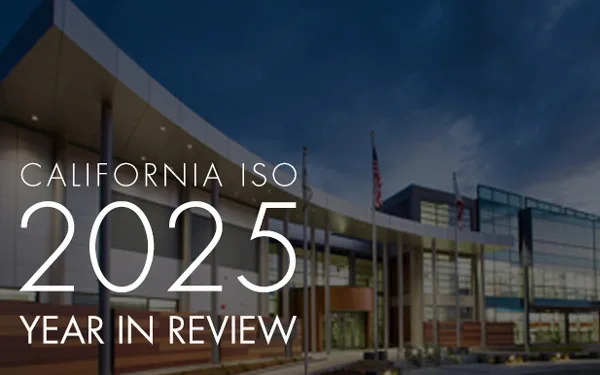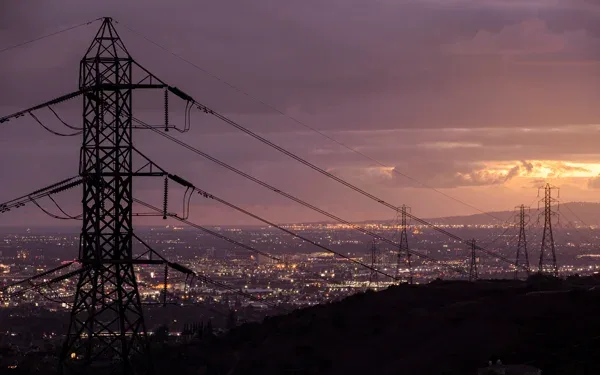2024 saw more shared progress on critical strategic objectives for grid reliability


As the year draws to a close, I would like to reflect on the past 12 months at the California Independent System Operator (ISO). I am pleased with the positive momentum we've achieved on critical strategic objectives. While there's always more to do, our 2024 accomplishments with partners and stakeholders have made the grid and ISO stronger, more resilient, and better prepared for the impacts of extreme weather and a changing resource mix.
The ISO has successfully integrated thousands of megawatts of new clean energy, secured federal regulatory approval for the ISO’s reformed interconnection process, and made significant strides in enhancing regional interconnectivity and resource sharing through improved transmission infrastructure.
Plans are meant to be executed and serve as a framework for organizational accountability. As I did last year, I want to review this year’s accomplishments through the lens of our 2022-2026 Strategic Plan.
To reliably and efficiently integrate new resources by proactively upgrading operational capabilities
The electric power industry is evolving rapidly, requiring grid operators to upgrade capabilities to manage system reliability and the changing resource mix. In 2024, the ISO’s Control Center Foundational Improvement & Modernization program strengthened core business functions and identified improvements for the grid's continued evolution.
Achievements in Foundational Improvements:
- Evaluated primary control room applications and user interfaces, developing a roadmap for enhancements.
- Refined Energy Management System alarms for accurate situational awareness.
- Adjusted Real-Time Contingency Analysis and Real-Time Dynamics Monitoring System parameters for stability and accuracy.
- Clarified expectations of Inverter-Based Resource behavior with customers.
- Developed new reports and improved assessments of next-day operational conditions.
- Refined parameters for manual day-ahead and real-time market load adjustments to manage reliability risks.
Achievements in Modernization:
- Invested in new training and simulation rooms at the Folsom headquarters for realistic training experiences and larger class sizes.
- Expanded and refined metrics to identify improvement areas and established a support team in the control room for user readiness and issue response.
- Conducted a baseline evaluation of current training programs to develop a roadmap for evolving operations training.
- Started evaluating and redesigning control room video walls to improve the use of essential software programs.
This workflow is now integrated into normal business processes, essential for maintaining grid reliability and the organization's continued success.
To strengthen resource adequacy and meet California’s SB 100 goals through long-term transmission planning and effective coordination with state agencies
To meet clean-energy goals and replace retiring natural gas plants, California needs to add about 7,000 MW of clean power annually for the next two decades. Through coordination with utilities and state agencies, historic amounts of new resources have been added to the system efficiently.
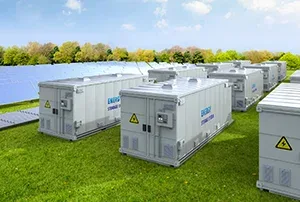
Since January 1, 2024, the ISO has integrated more than 6,100 MW of capacity, primarily in 4-hour lithium-ion batteries, bringing total battery storage to 10,781 MW as of December 2. These resources enhance reliability during hot summer evenings by charging during solar-rich hours and dispatching later.
As a result of the newly installed capacity, California met the industry standard for reliability, with 2,550 MW to spare, avoiding Flex Alerts despite extreme heat events. This was reflected in the 2024 Summer Loads and Resources Assessment and demonstrates a significant improvement over recent years.
The ISO also advanced transmission infrastructure needed to deliver power to consumers, including offshore wind that California is planning to develop under Senate Bill 100, aiming for a carbon-free grid by 2045.
Achievements in Transmission and Infrastructure:
- In May, the Federal Energy Regulatory Commission (FERC) approved the ISO’s subscriber participating transmission owner model (SPTO), enabling new transmission lines outside the ISO area to connect to the California grid. This model helps finance projects without increasing transmission access charges, allowing long-term renewable energy contracts. SPTO projects TransWest Express and SunZia will bring clean energy from Wyoming and New Mexico to California.
- The ISO’s 2023-2024 Transmission Plan included 26 new projects costing $6.1 billion to support 85 GW of capacity by 2035, including offshore wind from the North Coast.
- In June, the Ten West link transmission line was energized, connecting substations in Arizona and California, bringing more than 3,000 MW of clean power to consumers.
- In October, the ISO Board of Governors approved provisions for the Southwest Intertie Project – North, delivering Idaho wind energy to California and the Southwest, creating a crucial transmission pathway.
- Also in October, FERC approved a comprehensive series of interconnection process reforms. This followed a lengthy and robust stakeholder process in which the ISO’s Infrastructure and Operations Planning team worked hard to balance a diverse set of interests. In its order, FERC said the reforms will help “ensure that [interconnection] customers are able to interconnect to the transmission system in a reliable, efficient, transparent, and timely manner.”
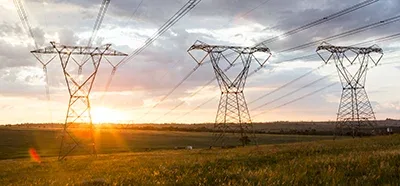
As transmission work progressed, the ISO, in collaboration with the California Energy Commission, California Public Utilities Commission, and the energy industry, updated its 20-Year Transmission Outlook, extending the planning horizon to 2045. This update incorporates recent project approvals and assesses the impact of load and resource forecast changes on future transmission needs. The 2024 Outlook highlights that anticipated load growth and major offshore wind generation are driving the estimated cost for future transmission needs from $30.5 billion when the ISO’s 20-Year Outlook was first published in 2022 to between $45.8 billion and $63.2 billion by 2045. Offshore wind development is the primary cost driver, influenced by design requirements, permitting timelines, routing decisions, and equipment and labor costs.
Additionally, California's transmission grid will benefit from a $600 million U.S. Department of Energy grant awarded in August to a consortium including state energy agencies, ISO, PG&E, and Southern California Edison. The grant funds upgrades to up to 100 miles of transmission lines with grid-enhancing technologies, improving reliability and delivering clean, affordable energy more efficiently.
To build on the foundations of the Western Energy Imbalance Market to further expand Western market opportunities
The Western Energy Imbalance Market (WEIM), launched in 2014, and Extended Day-Ahead Market (EDAM), set to launch in 2026, continued to gain momentum and new participants. By October, WEIM reported $6.25 billion in cumulative benefits for 21 balancing authorities across 11 western states. This fall, two Black Hills Corporation’s subsidiaries announced they will join WEIM along with BHE Montana in 2026, with BHE Montana also committing to EDAM, further expanding the market footprint and resource diversity.
The ISO continues to work on implementation plans with PacifiCorp and Portland General Electric, preparing for the 2026 launch of EDAM. In late November, the Balancing Authority of Northern California became the third entity to formally commit to join EDAM and other utilities, including the Los Angeles Department of Water & Power, Idaho Power, NV Energy, Public Service Company of New Mexico, and Arizona G&T Cooperatives, are also considering joining the extended day-ahead market.
The growing participation in WEIM and EDAM highlights the value of regional market offerings in reducing costs, enhancing reliability, and lowering greenhouse gas emissions.
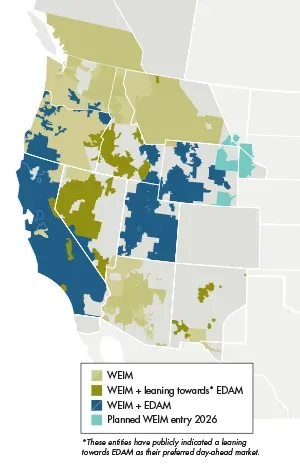
Also in 2024, the ISO supported the West-wide Governance Pathways Initiative, aimed at ensuring the benefits of wholesale electricity markets through a new governing organization. In August, the ISO’s Board of Governors and the Western Energy Markets (WEM) Governing Body approved the Pathways Step 1 proposal, transitioning greater authority over WEIM and EDAM to the Western Energy Markets (WEM) Governing Body once a trigger for EDAM participation has been met. The new governance model will give primary decision-making authority to the WEM Governing Body, replacing the current joint authority with the ISO Board of Governors. A “dual filing option” was introduced for resolving disputes between the two bodies. The proposal will take effect once EDAM has commitments from a geographically diverse set of non-ISO entities serving at least 70% of the ISO grid’s demand.
Throughout 2024, WEIM continued to enhance reliability across the region. During severe winter weather in January, market exports helped meet demand in the Pacific Northwest and Rocky Mountain states. In July, during a record heat event, the ISO maintained reliability with the help of WEIM and state agencies. Another heat wave in September saw the ISO manage peak demand effectively, maintaining reliability despite localized power interruptions.
As in all situations that put stress on the electric grid, the ISO works in close coordination with the State, load-serving entities, the California Energy Commission, California Public Utilities Commission and California Department of Water Resources, and neighboring balancing authorities to manage emergencies and communicate effectively.
Provide highly responsive and inclusive stakeholder engagement and customer service.
Highly responsive and inclusive stakeholder engagement and customer service are top priorities for the ISO. The teams work diligently to address stakeholder needs and emerging concerns, and to ensure full engagement in market design and implementation. The working group model for policy initiatives, first used successfully in designing the ISO’s extended day-ahead market, exemplifies effective stakeholder collaboration. This model gives stakeholders an active role in policy formation, resulting in more stakeholder-driven outcomes.
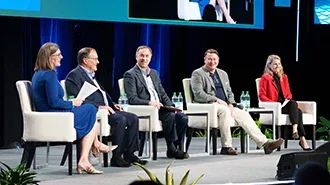
Process improvements are made based on feedback, including creating "at-a-glance" documents for a weekly snapshot of active policy initiatives. Summer readiness activities featured a regional leadership roundtable, customer training, and enhanced communication protocols, with a focus on battery operations training to ensure reliable performance.
The ISO organized a successful Stakeholder Symposium held on October 30, attracting 950 in-person and 500 online participants for discussions on regional markets, transmission projects, and the data economy. A highlight was a video commemorating the 10-year anniversary of the Western Energy Imbalance Market (WEIM).

On May 30, the ISO launched its new website, CAISO.com, offering an improved user experience and enhanced market and grid transparency.
One example of quick responsiveness to stakeholders this year was for an initiative that now allows resources with limited energy such as battery storage and hydro power to bid above the soft offer cap of $1,000 per megawatt hour, required under FERC rules. This change, approved by the Board of Governors in May and by FERC in July, ensures energy-limited resources are used effectively, especially during peak load hours.
Create a flexible and adaptive work environment that retains and attracts a highly skilled and engaged workforce.
In 2024 the ISO focused on maintaining a flexible work environment to retain and attract skilled employees. The flexible working arrangements helped bring on more than 65 new employees, filling important roles. Our long-running and robust internship program, which received over 28,000 applications for 30 slots, has expanded to provide year-round opportunities.
Modernized onboarding processes have helped to welcome hybrid and remote employees, ensuring a meaningful and effective start for new hires. The ISO has also invested in leadership development, with all managers participating in a 360-degree feedback process and receiving individualized development plans.
The commitment to diversity, equity, and inclusion (DEI) continued with the release of an inaugural DEI report and hosting discussions to communicate objectives and demystify DEI practices.
Retention and high employee engagement remained priorities, focusing on sustainable productivity, career development, and employee recognition. The ISO’s turnover remains at healthy, pre-pandemic levels.
2024 highlights on International Engagement
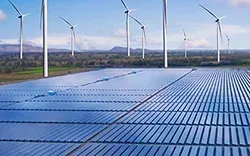
Since launching the Strategic Plan in 2022, the ISO has expanded its international outreach to share and exchange technical knowledge on integrating renewables and emerging grid technologies. Through the engagement with GO15, an international association of large grid operators, the ISO shares knowledge globally.
ISO experts participated in over ten one-on-one international exchanges and hosted more than 40 exchanges with teams from about 20 countries, including Australia, India, Japan, several European nations, South Africa, and Brazil.
The ISO also embarked on its first relocation exchange program, sending an operations expert to Italy’s Terna and an infrastructure planning lead to the Australian Energy Market Operator. This included a two-month knowledge-sharing exchange focused on inverter-based resources.
And in summer 2024, the ISO completed a joint study with the Electric Power Research Institute (EPRI) on advancing interconnection requirements for inverter-based resources.
Conclusion
Momentum and progress have defined 2024, thanks to collaboration with our partners and stakeholders. As we approach the winter holidays, I want to express my deep appreciation for the unwavering support from the ISO’s governing entities, state government partners, and many customers, stakeholders, and colleagues throughout the region.
Most importantly, my heartfelt gratitude goes to our dedicated and talented employees, contractors, and vendors. Your diligence, expertise, and professionalism have been crucial to our success.
Thank you, and best wishes for a healthy and joyous holiday season and a Happy New Year.
